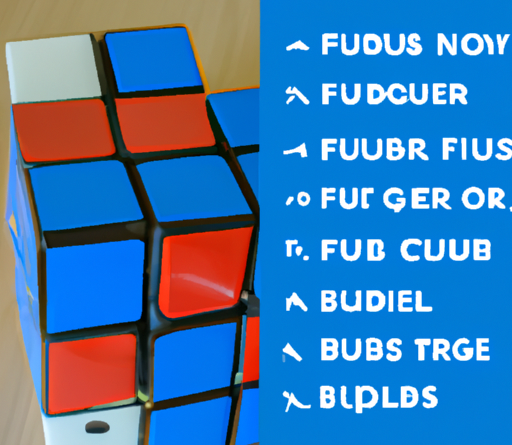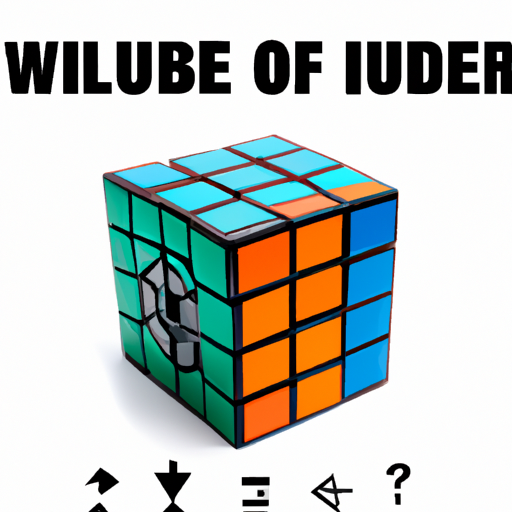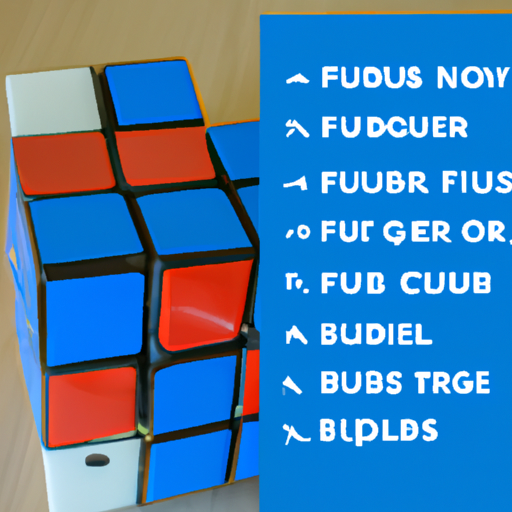
Do you ever find yourself staring at a Rubik’s Cube, wondering how on earth to solve it? It’s a fascinating puzzle that can leave even the best of us feeling perplexed. But fear not, because in this article, I’ll be breaking down the steps to help you solve the Rubik’s Cube. By the end, you’ll have a clear understanding of how to conquer this mind-boggling challenge.
First things first, solving a Rubik’s Cube requires a methodical approach. It’s not about randomly twisting and turning the sides until you stumble upon the solution. Instead, you need to follow a set of specific algorithms that will guide you towards the desired outcome. Don’t worry if this sounds complicated, though! I’ll be explaining each step in a straightforward and friendly manner, ensuring that you can easily grasp the techniques involved. So, if you’ve been yearning to finally solve that Rubik’s Cube that’s been gathering dust on your shelf, keep reading because you’re about to become a master at this classic puzzle.
Table of Contents
How to Solve a Rubik’s Cube

History of the Rubik’s Cube
The Rubik’s Cube is a 3-dimensional puzzle that was invented by Ernő Rubik, a Hungarian architect, in the early 1970s. Rubik initially created the puzzle as a way to help his students understand 3D geometry concepts. Little did he know that his creation would go on to become one of the most popular toys and puzzles in the world.
Invention of the Rubik’s Cube
In 1974, Rubik created the first prototype of the Rubik’s Cube. It was a wooden cube with colored stickers on each face, allowing for easy rotation. Rubik soon realized that his creation was not as easy as he initially thought. The puzzle consisted of 26 smaller cubes, known as cubies, that could be arranged in an astronomical number of ways.
Early Popularity
Rubik’s Cube gained popularity in Hungary in the late 1970s and eventually caught the attention of the international community. It was first showcased at the Nuremberg Toy Fair in 1979 and by 1980, the Rubik’s Cube was being sold all over the world. The puzzle quickly became a global sensation and a cultural phenomenon.
Global Phenomenon
The Rubik’s Cube’s popularity continued to grow throughout the 1980s. It was featured in numerous television shows, movies, and newspapers, making it a household name. People of all ages and backgrounds were captivated by the challenge of solving the puzzle. The Rubik’s Cube even inspired the creation of competitions and organizations dedicated to speedcubing, the art of solving the cube as quickly as possible.
Understanding the Basics
Before attempting to solve a Rubik’s Cube, it is important to understand its different parts and basic moves.
Different parts of the Rubik’s Cube
The Rubik’s Cube consists of three layers – a top layer, a middle layer, and a bottom layer. Each layer has nine cubies, with four edge cubies and four corner cubies on the top and bottom layers, and four edge cubies on the middle layer. The center cubies of each face are fixed and do not move.
Basic moves and rotations
The basic moves of the Rubik’s Cube are the R (right), L (left), U (up), D (down), F (front), and B (back) moves. Each move involves rotating a layer clockwise or counterclockwise by 90 degrees. For example, the R move rotates the right layer clockwise, the L move rotates the left layer clockwise, and so on. Additionally, the moves can be modified with an apostrophe (‘) to indicate a counterclockwise rotation and a 2 to indicate a 180-degree rotation.
Solving the First Layer
To successfully solve a Rubik’s Cube, it is best to break the process down into different layers. The first layer is often the easiest to solve.
Introduction to the first layer
The objective of the first layer is to solve a cross on the top face of the Rubik’s Cube using the center and edge cubies. The colors of the cross should match the colors of the adjacent center cubies.
Mastering the cross
To solve the cross, you need to manipulate the edge cubies on the top layer. By using the appropriate moves, you can position the edge cubies in a way that forms a cross with the color of the center cubies. This might require some trial and error, but with practice, you will become more efficient at solving the cross.
Completing the first layer corners
Once the cross is solved, the next step is to solve the four corner cubies of the first layer. This involves correctly orienting and permuting the corner cubies so that their colors match the surrounding center cubies.
Solving the Second Layer
After successfully solving the first layer, the next challenge is to solve the second layer.
Understanding the second layer
The second layer consists of four edge cubies that are positioned between the first and third layers. The goal is to correctly orient and place the edge cubies so that their colors match the surrounding center cubies.
Techniques to solve the second layer
There are different techniques to solve the second layer, but a commonly used method is the F2L (First Two Layers) method. This method involves solving the corner-edge pairs together, ensuring that they are oriented correctly and placed in the right position.

Solving the Third Layer
Once the first and second layers are solved, the final challenge is to solve the third layer.
Introduction to the third layer
The third layer consists of four edge cubies and four corner cubies. The objective is to orient the last layer edges and permute the last layer corners.
Orienting the last layer edges
To orient the last layer edges, you need to manipulate the edge cubies so that their colors match the adjacent center cubies. This can be done by using specific algorithms to cycle the edge cubies into their correct positions.
Permuting the last layer corners
Permuting the last layer corners involves rearranging the corner cubies so that their colors match the adjacent center cubies. Again, specific algorithms can be used to achieve this.
Advanced Techniques
For those looking to solve the Rubik’s Cube at a faster speed, advanced solving techniques can be learned.
Fridrich method
The Fridrich method, also known as the CFOP method (Cross, F2L, OLL, PLL), is a popular advanced solving method. It involves solving the cube in layers, starting with the cross, then the first and second layers, and finally the last layer, using specific algorithms for each step.
CFOP method
The CFOP method is similar to the Fridrich method and stands for Cross, F2L, OLL, PLL. It breaks down the process of solving the Rubik’s Cube into four distinct steps, allowing for efficient solving and fewer moves.
Roux method
The Roux method is another popular advanced solving method. It involves solving the cube in two stages, first solving the top and bottom layers, and then solving the middle layer using specific algorithms.
Speedcubing and Competitions
For those who have mastered the art of solving the Rubik’s Cube, speedcubing competitions offer a chance to showcase their skills.
Introduction to speedcubing
Speedcubing is the sport of solving the Rubik’s Cube as quickly as possible. Competitors use various solving methods and techniques to achieve incredibly fast times.
Popular speedcubing events
Speedcubing competitions are held worldwide and feature different events, including the 3×3 cube, 2×2 cube, one-handed solving, blindfolded solving, and even solving larger cubes such as the 4×4 and 5×5 cubes.
Tips for improving speed
To improve speed, speedcubers focus on practicing algorithms, optimizing finger movements, and developing efficient solving techniques. Regular practice and participating in competitions can greatly enhance solving speeds.
Common Mistakes and Troubleshooting
Solving a Rubik’s Cube can be challenging, and it’s common to make mistakes along the way. Here are some common mistakes and strategies to overcome them.
Identifying common mistakes
Common mistakes include misaligned edges, incorrectly placed cubies, and parity errors. By carefully inspecting the cube and analyzing the problem, you can identify the specific mistake that needs to be corrected.
Strategies to overcome obstacles
When encountering a difficult pattern or algorithm, it’s helpful to break it down into smaller, manageable steps. By practicing specific algorithms and techniques, you can gain the skills needed to overcome any obstacles that arise during the solving process.
Avoiding common pitfalls
The key to avoiding common pitfalls is to remain patient and methodical. Rushing through the solving process can lead to mistakes and frustration. Take your time, understand the algorithms and techniques, and always double-check your moves to ensure accuracy.
Additional Challenges
Once you have mastered solving the Rubik’s Cube, you may want to take on additional challenges.
Solving larger cubes
If you find the standard 3×3 Rubik’s Cube too easy, you can challenge yourself by solving larger cubes, such as the 4×4 or 5×5 cubes. These cubes introduce new algorithms and techniques, making the solving process even more complex.
Blindfold solving techniques
For those looking for a true test of memory and spatial awareness, blindfolded solving techniques offer a unique challenge. By memorizing the cube’s initial state and using specific algorithms, it is possible to solve the Rubik’s Cube while blindfolded.
One-handed solving
Solving a Rubik’s Cube using only one hand is another impressive challenge. It requires precise finger movements and coordination, but with practice, it can be accomplished.
Conclusion
Solving a Rubik’s Cube may seem daunting at first, but with the right techniques and practice, anyone can become a master. By understanding the history and basics of the Rubik’s Cube, learning step-by-step solving methods, and exploring more advanced techniques, you can unlock the secrets of this iconic puzzle. Whether you solve it for fun or become a speedcubing champion, the Rubik’s Cube offers endless hours of entertainment and the potential benefits of improved memory, spatial awareness, and problem-solving skills. So go ahead, grab a Rubik’s Cube, and embark on your own journey to solve this timeless puzzle. Happy cubing!

